Axis Deer vs. Whitetail: A Comparison of Two Iconic Deer Species

Table of Contents
Table of contents
Introduction
For avid hunters and wildlife enthusiasts, encounters with deer are a common and cherished experience. In North America, two prominent deer species stand out: the Axis Deer and the Whitetail Deer. Each possesses unique characteristics, habitats, and behaviors that set them apart. In this comparative guide, we’ll delve into the key differences between Axis Deer and Whitetail Deer, providing insight into their appearances, distributions, behaviors, and hunting characteristics. So, let’s embark on a journey to explore the distinct worlds of these two iconic deer species!
1. Physical Characteristics
Axis Deer (Axis axis)
The bizarre Elegance
Axis Deer, also known as Chital or Spotted Deer, hail from India and Sri Lanka. Their most distinct feature is their beautiful reddish-brown coat adorned with white spots, reminiscent of a regal coat of arms.
Majestic Antlers
Male Axis Deer grow impressive antlers, which are typically three-pronged and can reach lengths of up to 30 inches. Female Axis Deer, on the other hand, lack antlers.
Whitetail Deer (Odocoileus virginianus)
Graceful Beauty
Whitetail Deer are native to North America and are renowned for their elegant and graceful appearance. Their coat color varies with the seasons, transitioning from reddish-brown in summer to a grayish-brown in winter.
White Tails and Antlers
Whitetail Deer derive their name from the distinctive white underside of their tails, which they raise as a warning signal when alarmed. Both male and female Whitetail Deer can grow antlers, with males typically having larger and more complex antlers.
2. Habitat and Distribution
Axis Deer
Introduction to New Lands
Axis Deer were introduced to various countries worldwide, including the United States, where they thrive in states like Texas and Hawaii. They prefer habitats that offer a mix of open grasslands, dense forests, and water sources.
Whitetail Deer
North American Natives
Whitetail Deer are indigenous to North America and have one of the most extensive distributions of any large mammal on the continent. They inhabit a wide range of environments, including forests, grasslands, and suburban areas.
Axis Deer
Social Herds
Axis Deer are known for their social nature, often forming herds that include individuals of various ages and sexes. These herds can range from a few individuals to larger groups.
Vocalization
Axis Deer communicate through various vocalizations, including barks and alarm calls, especially when they sense danger.
Whitetail Deer
Solitary and Family-Oriented
Whitetail Deer are typically solitary animals, except during the mating season and when females are rearing fawns. They establish territories and communicate through scent marking and vocalizations, including grunts and snorts.
Alertness and Vigilance
Whitetail Deer are highly alert and vigilant, relying on their keen senses, especially their exceptional sense of smell and hearing, to detect predators.
4. Hunting Characteristics
Axis Deer
A Prized Game
Axis Deer are a popular game species for hunters in regions where they have been introduced. Their beauty and elusive nature make them a sought-after trophy.
Thrilling Pursuit
Hunting Axis Deer often involves stalking through diverse terrains, adding an element of excitement to the hunt. Their sharp senses and swift movements pose a challenge for hunters.
Whitetail Deer
The Quintessential American Game
Whitetail Deer are the most popular and widely hunted big game species in North America. Their abundance, challenging behavior, and delicious venison make them a cherished hunting opportunity.
Hunting Styles
Whitetail Deer can be hunted using various methods, including stand hunting, spot-and-stalk, and still hunting. Their adaptability and varied habits provide hunters with diverse hunting experiences.
Conclusion
While Axis Deer and Whitetail Deer share the allure of the deer family, they stand apart as unique representatives of their respective regions. The Axis Deer’s fascinating elegance and social herds bring a touch of India to new lands, while the Whitetail Deer’s graceful beauty and widespread presence define the American hunting experience. As hunters and wildlife enthusiasts, we celebrate the distinctive attributes and behaviors of these two iconic deer species, cherishing every opportunity to encounter them in the wild and participate in responsible and sustainable hunting practices.
FAQs (Frequently Asked Questions)
1. Are Axis Deer considered invasive in regions where they have been introduced? Yes, in some regions, Axis Deer populations have grown to the point of being considered invasive. They can impact local ecosystems and compete with native wildlife for resources.
2. Do Axis Deer and Whitetail Deer interbreed when their habitats overlap? Interbreeding between Axis Deer and Whitetail Deer is unlikely due to their geographic separation and genetic differences.
3. Can Axis Deer and Whitetail Deer coexist in the same habitat without competition? While both species prefer different habitats, they could potentially coexist in regions with diverse ecosystems and ample resources.
4. Which deer species is more challenging to hunt, Axis Deer, or Whitetail Deer? The level of difficulty in hunting Axis Deer or Whitetail Deer depends on various factors, including the environment, population densities, and the hunter’s skills. Both species offer unique hunting challenges and rewarding experiences.
5. Are there specific regulations for hunting Axis Deer and Whitetail Deer in different states? Yes, hunting regulations and seasons for Axis Deer and Whitetail Deer vary by state. Hunters must obtain the necessary licenses, adhere to bag limits, and comply with specific regulations set by each state’s wildlife management agencies.







